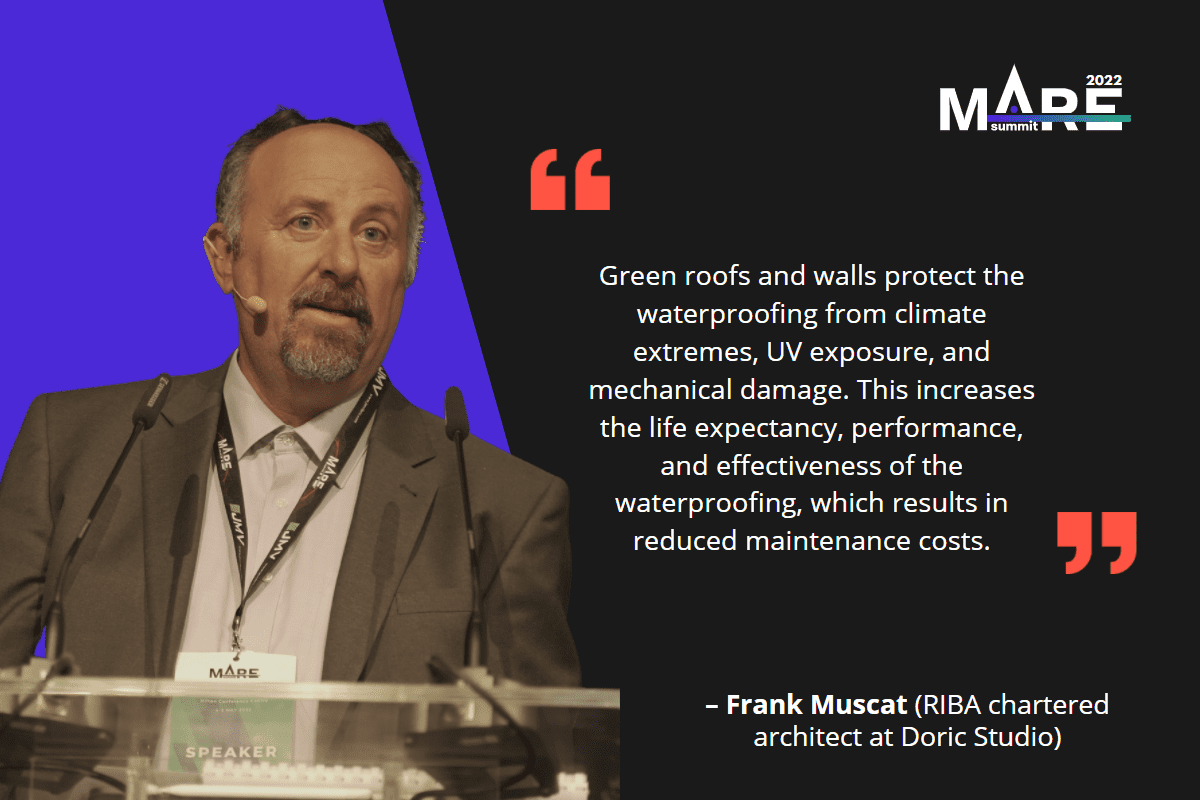Conference: Building with Nature
Speaker
Frank Muscat – Founder and CEO at Doric Studio and Living Walls
Conference
During the conference he delivered at MARE Summit 2022, Perit Frank Muscat, technical landscaper and director of Doric Studio, expounded on the advantages of building with nature in mind, and how the integration of green roofs and green walls can turn our buildings not only more environmentally sustainable, but also aesthetically more pleasing.
Before sharing two case studies of urban greening interventions undertaken by Living Walls, the landscape branch of architecture firm Doric Studio, Muscat summarized the negative impacts of unfettered human activity and listed some of the ways in which green roofs and walls can help mitigate some of them
Consequences of uncontrolled human activity on the environment
CLIMATE CHANGE
Changing weather patterns, extreme events, such as heat waves, are becoming more prevalent.
SEAL LEVEL RISE
Sea levels are projected to rise 30 centimetres in 30 years.
FLOODING
The more we build up, the more we take away the sealing (natural drainage layer) of the countryside, which increases the frequency and intensity of floods.
HEAT ISLAND EFFECT
The paved areas where we live and work tend to be several degrees higher than the surrounding countryside, as they are not cooled by the shade, transpiration and evaporation that vegetation and water retention bodies provide.
URBAN SPRAWLING
Over-development and poor design have led to the loss of open spaces, urban degradation, increased demand on energy, pollution, traffic congestion etc.
Benefits of green roofs and walls
BIODIVERSITY
Landscaped areas and walls provide a natural habitat which fosters biodiversity.
AIR PURIFICATION
Vegetation filters out dust and smoke particles from the air. Nitrogenous carbon dioxide and other toxins are absorbed by the plants and converted into much-needed oxygen.
MICRO-CLIMATE
Green roofs and walls cool and humidify the surroundings, thus creating beneficial micro-climates and reducing the heat island effect.
WATER MANAGEMENT
Installing a green roof can save construction costs. Its drainage layer can reduce water run-off by 50-90%, thus reducing the total capacity needed for outlets, pipes, and drains.
THERMAL INSULATION
Green roofs and walls have the ability to buffer extreme temperatures, improving the energy performance of buildings.
ACOUSTIC INSULATION
Planted areas are natural sound insulators (up to 3 dB reduction in reflective sound, improved sound insulation of up to 8 dB), which makes green roofs and walls particularly effective for buildings near airports, busy roads, and noisy surroundings.
Green roofs and walls protect the waterproofing from climate extremes, UV exposure, and mechanical damage. This increases the life expectancy, performance, and effectiveness of the waterproofing, which results in reduced maintenance costs.
REDUCED RENOVATION COSTS
SUPPORT RECYCLING
Green roofs and walls make extensive use of recycled and recyclable products, saving further valuable resources. Rubber, polyethylene, expanded polystyrene, rigid foam, and, more recently, biomass materials, such as sugarcane, are only some of the elements used in green roofs and walls.

Vertical garden at Marsa-Ħamrun bypass
This 368-meters-long vertical garden, the first one in Malta, overlooks a very busy arterial road and required the joint effort of horticulturalists, landscape architects, engineers, and gardeners.
It has a surface area of 700 square meters, faces southwest, and is fully exposed to the sun.
The segments were one meter, two meters, and three-meters in size. They were placed over and above a one-meter impact zone, which was left free.
As it is usually the case when designing green walls, evergreen perennials were chosen, as they look lush all year round. For this particular project, over 27,600 plants from 17 different species were installed.

Roof garden at Valletta Design Cluster
Once the waterproofing layers, root barriers, and water drainage are installed, it’s up to the designer’s imagination what to do next: rock ponds, pathways, timber structures, soft areas.
The purpose-built roof garden at the Valletta Design Cluster, which was a result of a collaboration with the Restoration Directorate and architectural firm Tetsuo Kondo, has a surface area of 495 square meters, dedicated in roughly equal measure to soft and hard landscaping.
The spaces meant for social gatherings, paved in solid Ipe wood, are reached by walking on a series of stepping stones made from local hard stone. There is also a natural rock pond with papyrus plants, water lilies, and freshwater fish.
A serpentine pathway, finished in permeable aggregate, is flanked with lush vegetation on both sides. 50 centimeters of substrate serve as the growth medium of over 950 shrub, ground cover, climber, bulb, grass, and tree specimens, including mature olive trees.
Updates and further information about the summit’s developments can be followed on the official blog and on its social media channels.



